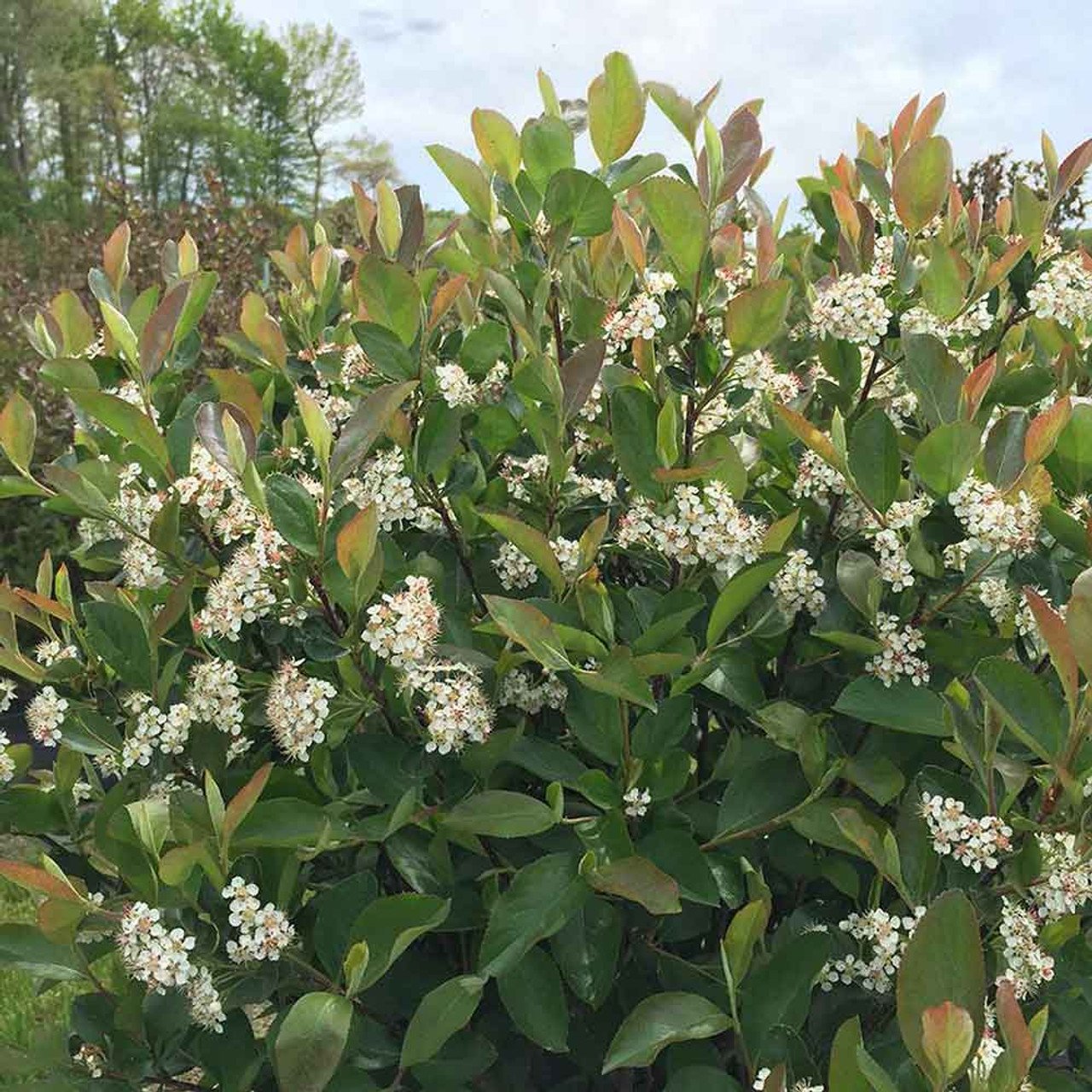Aronia
Aronia melanocarpa. Commonly called black chokeberry; an open, upright, spreading, somewhat rounded but leggy, suckering, deciduous shrub that typically grows 3-6’ tall and wide. It is native to low woods, swamps, bogs and moist thickets but occasionally to dry upland areas in eastern North America. Known for its noticeable (but not exactly showy) clusters of white 5-petaled spring flowers, glossy dark green leaves, black autumn berries (roughly the size of blueberries), and purple/red fall color. Tolerates a wide variety of soils types and growing conditions from wet shade to dry full sun; berry production and growth will be best in full sun. Handsome plants when established; can sucker and spread over time if not managed. Self-fertile but two varieties or one plus a seedling will improve production.
The berry, though very bitter when eaten raw, has the highest polyphenol content…ever. It is the most powerful antioxidant you can find, five times higher than blueberries or cranberries, mine as well have it in your back yard. Also one of the only reliable fruit producers for wet soils. Useful in pies, jams, jellies, juices, wine, and meads.
melanocarpa: straight species seedling gown from local cuttings or seed, will still produce good fruit but not a selected cultivar breed for production
Galicjenka: a newer cultivar that is similar to Viking which is used to produce fruit in Russia for pie production, and may also be processed into juice.
Nero: also similar to Viking in fruit and foliage but stays smaller, typically topping out at 4 feet.
Aronia melanocarpa. Commonly called black chokeberry; an open, upright, spreading, somewhat rounded but leggy, suckering, deciduous shrub that typically grows 3-6’ tall and wide. It is native to low woods, swamps, bogs and moist thickets but occasionally to dry upland areas in eastern North America. Known for its noticeable (but not exactly showy) clusters of white 5-petaled spring flowers, glossy dark green leaves, black autumn berries (roughly the size of blueberries), and purple/red fall color. Tolerates a wide variety of soils types and growing conditions from wet shade to dry full sun; berry production and growth will be best in full sun. Handsome plants when established; can sucker and spread over time if not managed. Self-fertile but two varieties or one plus a seedling will improve production.
The berry, though very bitter when eaten raw, has the highest polyphenol content…ever. It is the most powerful antioxidant you can find, five times higher than blueberries or cranberries, mine as well have it in your back yard. Also one of the only reliable fruit producers for wet soils. Useful in pies, jams, jellies, juices, wine, and meads.
melanocarpa: straight species seedling gown from local cuttings or seed, will still produce good fruit but not a selected cultivar breed for production
Galicjenka: a newer cultivar that is similar to Viking which is used to produce fruit in Russia for pie production, and may also be processed into juice.
Nero: also similar to Viking in fruit and foliage but stays smaller, typically topping out at 4 feet.
Aronia melanocarpa. Commonly called black chokeberry; an open, upright, spreading, somewhat rounded but leggy, suckering, deciduous shrub that typically grows 3-6’ tall and wide. It is native to low woods, swamps, bogs and moist thickets but occasionally to dry upland areas in eastern North America. Known for its noticeable (but not exactly showy) clusters of white 5-petaled spring flowers, glossy dark green leaves, black autumn berries (roughly the size of blueberries), and purple/red fall color. Tolerates a wide variety of soils types and growing conditions from wet shade to dry full sun; berry production and growth will be best in full sun. Handsome plants when established; can sucker and spread over time if not managed. Self-fertile but two varieties or one plus a seedling will improve production.
The berry, though very bitter when eaten raw, has the highest polyphenol content…ever. It is the most powerful antioxidant you can find, five times higher than blueberries or cranberries, mine as well have it in your back yard. Also one of the only reliable fruit producers for wet soils. Useful in pies, jams, jellies, juices, wine, and meads.
melanocarpa: straight species seedling gown from local cuttings or seed, will still produce good fruit but not a selected cultivar breed for production
Galicjenka: a newer cultivar that is similar to Viking which is used to produce fruit in Russia for pie production, and may also be processed into juice.
Nero: also similar to Viking in fruit and foliage but stays smaller, typically topping out at 4 feet.




